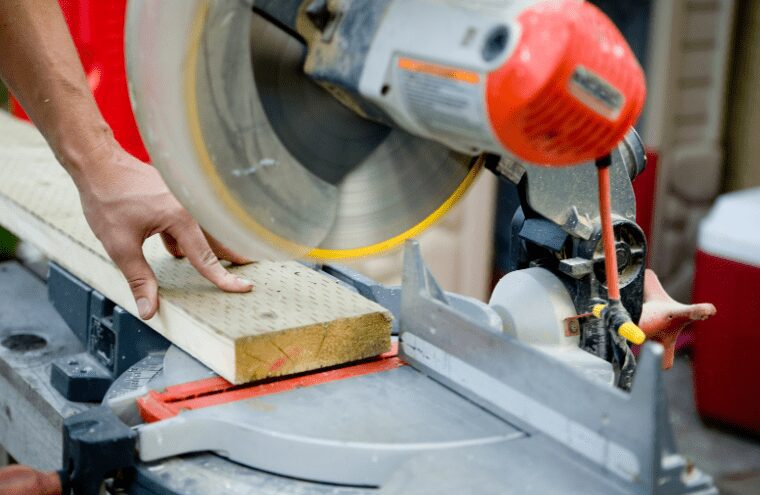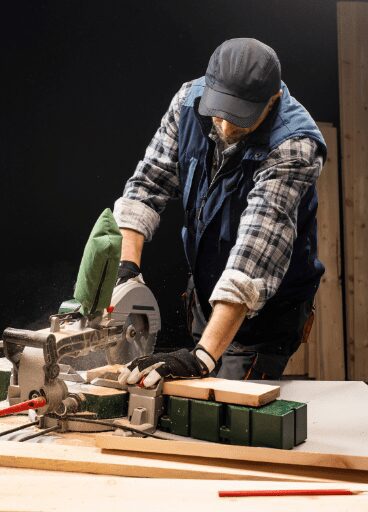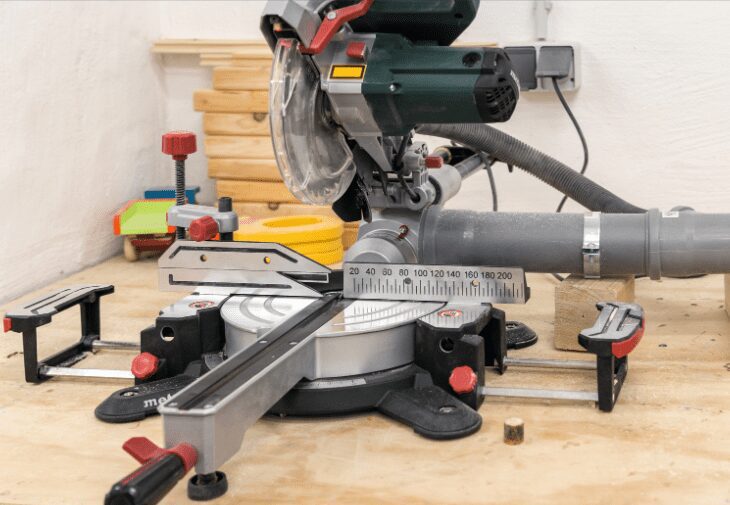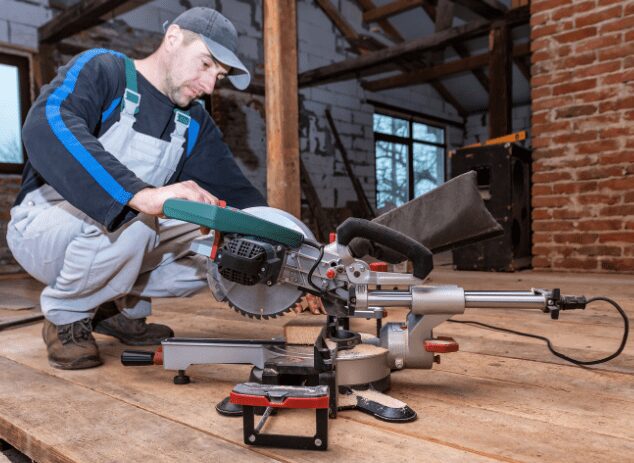
A miter saw is a power tool used to make accurate crosscuts and miters in various materials. It has a circular blade mounted on a swing arm that can be angled and adjusted to make precise cuts. Miter saws are ideal for making angled cuts on baseboards, crown moldings, picture frames, and more.
Types of Miter Saws
There are different types of miter saws, including standard miter saws, compound miter saws, sliding compound miter saws, and dual compound miter saws. The type of miter saw you choose will depend on your project requirements and budget. Let’s take a closer look at the different types of miter saws.
Standard Miter Saw

A standard miter saw is a type of power tool that is commonly used to make angled cuts on a workpiece. It is typically the most basic and affordable type, and can be used to make miter cuts, which are angled cuts across the width of the workpiece.
Standard miter saws are suitable for basic DIY projects and smaller workpieces, but may not be sufficient for professional woodworking projects that require more complex cuts. They typically have a fixed arm and blade that can pivot to the desired angle to make the cut, and can be adjusted to make precise cuts at various angles.
Standard saws are a great entry-level tool for those looking to get started with woodworking, and are a versatile addition to any workshop.
Compound Miter Saw
A compound miter saw is commonly used to make angled cuts on a workpiece. It is similar to a standard version, but with the added ability to make bevel cuts, which are angled cuts across the thickness of the workpiece.

Compound miter saws are suitable for more complex woodworking projects, as they offer the versatility of being able to make both miter and bevel cuts.
They typically have a tilting blade that can pivot to the desired angle for the bevel cut, and can also be adjusted to make precise cuts at various angles for the miter cut.
These are a great tool for woodworkers who require more flexibility in their cutting capabilities and are looking to take on more challenging projects.
Sliding Compound Miter Saw

This saw comes with the added feature of a sliding arm that allows the saw blade to move forward and backward. This sliding feature increases the cutting capacity of the saw, making it easier to cut through larger workpieces.
Like a compound version, it can make both miter and bevel cuts, and is a popular tool among professional woodworkers and contractors who need to make precise cuts on larger pieces of wood, such as baseboards, crown molding, or hardwood flooring.
Sliding miter saws can also be adjusted to make precise cuts at various angles and are available in a variety of blade sizes and power capacities to suit different needs.
Dual Compound Miter Saw

A dual compound miter saw has added feature of being able to tilt the blade in both directions. This allows the saw to make bevel cuts at any angle without having to flip the workpiece over.
Like a compound version, it can also make miter cuts, which are angled cuts across the width of the workpiece. This dual tilting feature makes it easier to create more complex cuts and angles with greater accuracy and precision.
Dual compound miter saws are available in both sliding and non-sliding models and can be adjusted to make precise cuts at various angles.
They are commonly used by professional woodworkers and contractors who require the ability to make more complex cuts with greater ease and efficiency.
Cordless miter saws
Cordless miter saws are using rechargeable batteries instead of being tethered to an electrical outlet. These saws offer greater mobility and flexibility compared to their corded counterparts, as they can be used in locations where an electrical outlet is not available.
Overall, cordless miter saws are a great option for woodworkers who require more flexibility and mobility in their projects, but may not be suitable for larger, more complex cutting tasks.
How to Use
Using a miter saw may seem intimidating, but with the right steps, you can become a pro in no time.
Here’s a step-by-step guide:
Step 1
Choose the right blade. Selecting the right blade is crucial to get the best results. The type of blade you use depends on the material you are cutting. A fine-toothed blade is best for cutting wood, while a blade with fewer teeth is ideal for metal or plastic. Make sure the blade is sharp and properly installed before using it.
Step 2
Set up the saw. Setting up the miter saw is an essential step to ensure accuracy. Start by adjusting the bevel and miter angles to your desired settings. Then, secure the material cutting to the saw’s base using clamps or a vice grip. Ensure the material is positioned correctly so that the blade won’t bind or kickback during the cut.
Step 3
Make precise cuts Before you start cutting, double-check the settings and the position of the material. When you are ready, slowly lower the blade and make the cut, keeping your hands and fingers clear of the blade. Be patient and let the blade do the work. Once the cut is complete, release the saw and lift the blade back to the starting position.
Safety Tips
Miter saws are powerful tools that can cause severe injuries if not used properly.
Here are some safety tips to keep in mind:
1. Wear safety gear
Always wear safety glasses, ear protection, and a dust mask when using a saw. Wear gloves to protect your hands if the material you’re cutting is metal.
2. Keep your hands and fingers away from the blade
Never touch the blade or try to remove cut-off pieces until the blade has completely stopped moving.
3. Keep the workspace clean
Remove all debris and clutter from the work area to avoid tripping hazards. Make sure the floor is dry and free of any liquids.
4. Don’t force the saw
Let the blade cut; don’t force the saw through the material. Stop the saw and adjust the settings if the blade is binding or not cutting properly.
5. Never leave the saw unattended
Turn off the saw and unplug it when not in use. Keep it out of reach of children and pets.
Top Miter Saws in the Market
1. DEWALT DWS780 12-Inch Double Bevel Sliding Compound Miter Saw
The DEWALT DWS780 is a 12-inch comes with a powerful 15-amp motor that delivers 3,800 RPM. It has a double bevel feature allows you to tilt the blade in both directions, making it easier to create bevel cuts on a workpiece.
The sliding feature increases the cutting capacity, allowing you to cut larger workpieces. The DEWALT DWS780 also has an XPS cross-cut positioning system that provides a bright LED light to cast a shadow on the workpiece, making it easier to see the cut line.
This saw is suitable for professional woodworkers and contractors who require precision and accuracy.
2. Bosch Power Tools GCM12SD – 15 Amp 12 Inch Corded Dual-Bevel Sliding Glide Miter Saw
The Bosch Power Tools GCM12SD is a 12-inch sliding glide miter saw with a dual-bevel feature, allowing you to tilt the blade in both directions. The sliding glide feature provides a smooth and precise cutting experience, making it easier to cut through different materials.
Its powerful 15-amp motor delivers 3,800 RPM, ensuring you can work on your projects efficiently. The Bosch Power Tools GCM12SD also has a square lock fence system that always ensures a straight and accurate cut.
It is ideal for professional woodworkers and contractors who require precision and accuracy.
3. Makita LS1019L 10″ Dual-Bevel Sliding Compound Miter Saw with Laser
The Makita LS1019L is a 10-inch saw is equipped with a dual-bevel feature, allowing you to tilt the blade in both directions. It has a laser system that projects a line on the workpiece, making it easier to see the cut line.
The sliding feature provides a smooth and precise cutting experience, making it easier to cut through different materials. Its powerful 15-amp motor delivers 3,200 RPM, ensuring you can work on your projects efficiently.
The Makita LS1019L also has a unique direct-drive gearbox and guard system that increases vertical cutting capacity. It is ideal for woodworkers who require precision and accuracy.
4. Hitachi C12RSH2 15-Amp 12-Inch Dual Bevel Sliding Compound Miter Saw
The Hitachi C12RSH2 is a 12-inch saw features a dual-bevel option, allowing you to tilt the blade in both directions. The sliding feature provides a smooth and precise cutting experience, making it easier to cut through different materials.
Its powerful 15-amp motor delivers 4,000 RPM, ensuring you can work on your projects efficiently. The Hitachi C12RSH2 also has a laser marker system that projects a line on the workpiece, making it easier to see the cut line.
This saw is suitable for professional woodworkers and DIY enthusiasts who require precision and accuracy.
Conclusion
Choosing the best miter saw for your woodworking projects requires careful consideration of various factors such as blade diameter, spinning blade, miter saw models, sliding miter saw, blade guard, and many others.
The most popular and versatile types of miter saws include compound, dual compound, sliding compound, and corded miter saws. While corded miter saws offer more power, cordless miter saws provide greater mobility and convenience.
Other features such as laser guides, electric brakes, and dust extraction also contribute to the safety and efficiency of the saw.
Whether you are a professional woodworker, DIY enthusiast, or general contractor, the right miter saw can make a significant difference in the quality and precision of your projects.
FAQ:
Q: What is a sliding miter saw?
A: A sliding miter saw is a type of miter saw that has a sliding arm that allows the blade to move forward and backward, increasing the cutting capacity of the saw.
Q: What is a dual compound miter saw?
A: A dual compound miter saw is a type of miter saw that can tilt the blade in both directions, making it easier to make bevel cuts without having to flip the workpiece over.
Q: Can all miter saws cut metal?
A: Not all miter saws can cut metal. Some miter saws are designed to cut only wood and other materials, while others are capable of cutting through metal.
Q: What is the difference between a compound and a sliding compound miter saw?
A: A compound miter saw can make both miter and bevel cuts, while a sliding compound miter saw has a sliding arm that allows the blade to move forward and backward, increasing the cutting capacity of the saw.
Q: What is the advantage of a cordless miter saw?
A: The advantage of a cordless miter saw is its mobility and convenience, as it can be used in locations where an electrical outlet is not available.
Q: Can a miter saw be used for trim work?
A: Yes, a miter saw is commonly used for trim work such as baseboards, crown molding, window casings, and door frames.
Q: What safety features should a miter saw have?
A: A miter saw should have a blade guard, safety clamp, and positive stops to prevent the user from accidentally cutting themselves or the workpiece. It should also be equipped with a dust extraction system to collect sawdust and prevent it from getting airborne and into the user’s lungs.
Q: What is the best blade size for a miter saw?
A: The best blade size for a miter saw depends on the type of work you will be doing. For general woodworking and trim work, a 10-inch or 12-inch blade is sufficient. For larger projects, a 12-inch blade is recommended.
Q: What is a laser guide in a miter saw?
A: A laser guide in a miter saw projects a line onto the workpiece, helping the user to see exactly where the blade will make the cut.
Q: How does a miter saw differ from a circular saw?
A: A miter saw is designed to produce angled cuts, while a circular saw is used to make straight cuts. A miter saw is more suitable for trim work and other precise cuts, while a circular saw is better for cutting larger pieces of wood or other materials.
Q: What is the importance of blade guards in a miter saw?
A: Blade guards in a miter saw help to prevent the user from accidentally coming into contact with the blade, reducing the risk of injury.
Q: Can a miter saw be used for cutting other materials besides wood?
A: Yes, a miter saw can be used for cutting other materials such as plastic, aluminum, and certain types of metal. However, it is important to use the appropriate blade for the material being cut.
Q: What is a chop saw?
A: A chop saw is a type of saw that is similar to a miter saw, but is designed specifically for making straight cuts at 90-degree angles.
Q: What is a radial arm saw?
A: A radial arm saw is a type of saw that has a spinning blade attached to an overhead arm that can be pivoted and adjusted to make various types of cuts.
Q: What are the most common angles used in miter saws?
A: The most common angles used in miter saws are 45 degrees and 90 degrees, which are commonly used in trim work and other woodworking projects.
Q: What is the difference between a manual miter box and a power miter saw?
A: A manual miter box is a tool used to make precise cuts at specific angles, while a power miter saw is a power tool that can make angled cuts quickly and efficiently.
Q: What is the best way to collect sawdust when using a miter saw?
A: The best way to collect sawdust when using a miter saw is to use a dust extraction system that is attached to the saw and collects sawdust as it is produced.
Whether you are a beginner or an experienced woodworker, the right miter saw can make all the difference in your projects.
By understanding the different types of miter saws, blade sizes, and features, you can select the one that best meets your needs and preferences. Be sure to prioritize safety features such as blade guards and positive stops to minimize the risk of injury.
With the right miter saw, you can achieve precision and accuracy in your woodworking projects and create beautiful pieces that will last for years to come.
Last update on 2024-11-21 / Affiliate links / Images from Amazon Product Advertising API





























